3 Shocking Discoveries I’ve Made While Searching Cemeteries
There has always been something mysterious about cemeteries. Perhaps the knowledge that those interred took secrets to their grave has resulted in the enigmatic haze that seems to linger over these peaceful resting sites. But it’s not just the dead that hold secrets. Cemeteries themselves are often home to puzzling (and sometimes spooky) features.
Joy Neighbors, author of the book The Family Tree Cemetery Field Guide shares three of her most shocking finds while scouring cemeteries for genealogical clues.
Tombstone Tourist
We think of cemeteries as quiet tranquil places. As a “Tombstone Tourist,” I’ve spent years in cemeteries searching for genealogy clues, exquisite artwork, stunning vistas, and that perfect photograph. A trip to the graveyard is never boring. I’ve come back with tales of beauty, delight, and terror. Here are just three shocking discoveries I’ve made while searching in cemeteries.
1. Abandoned Crypts
There’s a cemetery in Kentucky that holds a baffling find; three 19th century mausoleums that have disappeared right in the middle of the grounds.
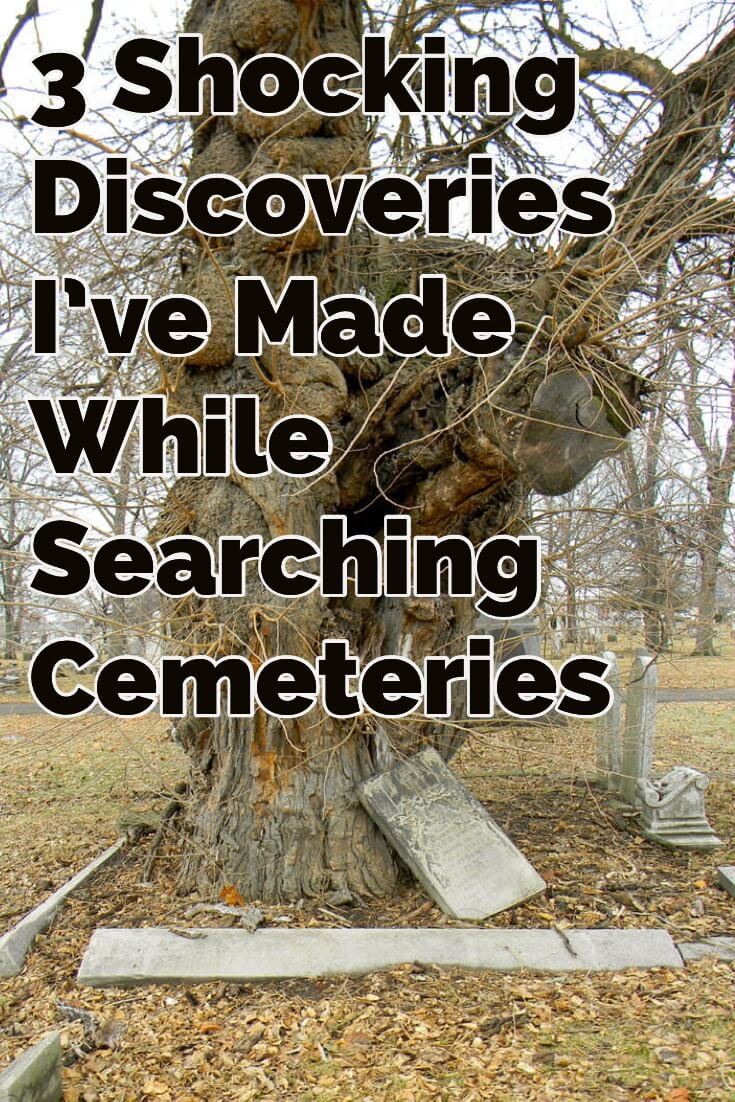
On a humid July day, I stepped inside a grove of trees to escape the searing heat. Inside that cool dimness stood three stately mausoleums, each with a façade protruding from a hill now enveloped in trees, vines, and shrubs. This thicket had been growing untamed for years.
The mausoleums stood side-by-side. The first was a small brick crypt with a surname above the entry along with a date “1895.” But the tomb had been bricked up for so long, trees grew on top obscuring its existence.
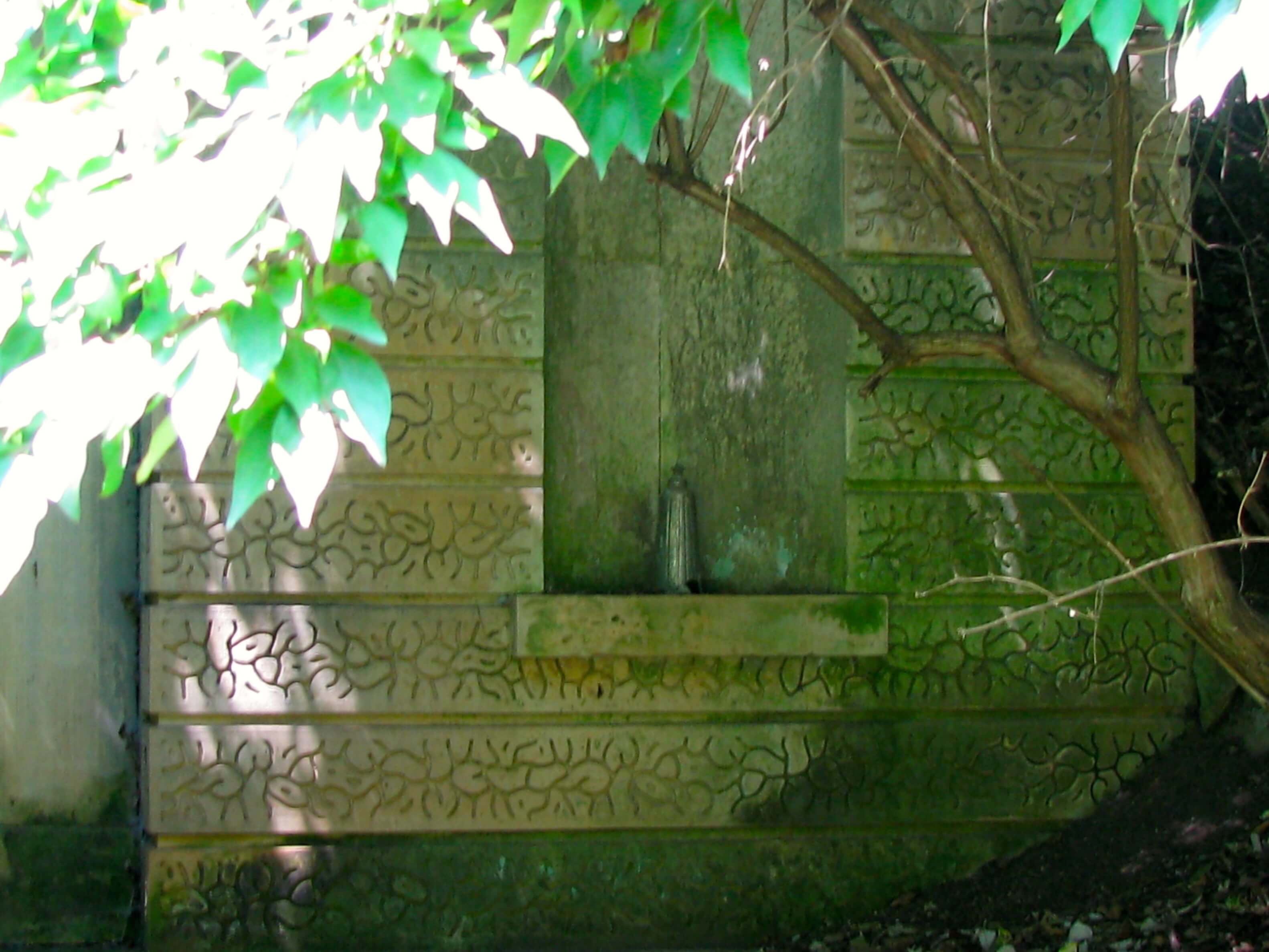
The middle mausoleum was built from pressed concrete with niches and arches along the walls. Again, the doorway and windows were bricked shut against the onslaught of trees and ropy vines that brushed and clung to its surface.
The third mausoleum was constructed of plainer concrete set off in a corner. No names or dates were visible but trees blocked any approach. It was visible only through a tangle of vines and foliage.
Who had these monuments been for?
Why had they been abandoned?
Had the bodies been moved when family members relocated?
Or were they simply forgotten?
Perhaps no one left payment for special care in perpetuity.
Apparently, what has been lost and forgotten shall remain so.
2. The Grave in the Middle of the Road
Having grown up in Indiana, I can assure you that Hoosiers are a practical lot. But there’s one roadside attraction that will cause the most stoic of residents to stop and ponder the audacity and fortitude it took to keep a grave in the middle of the road for close to 200 years.
The story began in 1808 when Nancy Kerlin married William Barnett, the great, great, great grandson of Pocahontas and John Rolfe.
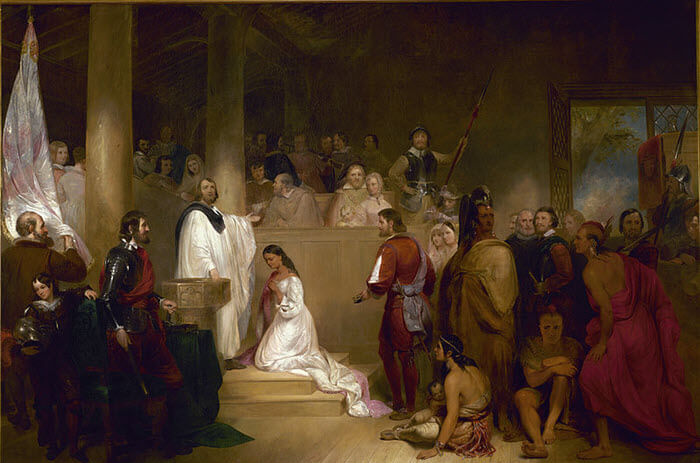
Baptism of Pocahontas by John G. Chapman, 1840. (Public Domain Image)
They settled near what would become Amity, Indiana to raise their family.
Nancy died on December 1, 1831 and was buried on top of a small hill overlooking Sugar Creek, one of her favorite spots. Soon others were also buried here and over the years a small county cemetery developed.
But then progress reared its head around the turn of the last century and Johnson County decided that a road needed to be built to connect Amity with other thoroughfares. This meant the grave had to be relocated.
Nancy’s grandson, Daniel G. Doty had a problem with that.
Doty went to the county and voiced his opposition. Nothing changed so he decided to take matters into his own hands. When county work crews arrived they found Doty sitting on his grandmother’s grave – with a loaded shotgun. Again, Doty told the county that his grandmother would stay where she was. If they insisted on trying to move her grave, they would have to deal with him. With that prospect, county workers agreed to let things “rest” where they were.
A concrete slab was placed over the grave in 1912 to protect it.
An historical marker was added in 1982, and Nancy became an anomaly.
But three years ago, after numerous reports of accidents, something had to be done.
In 2016, Nancy’s grave was temporarily moved to widen the road. It was the perfect time for University of Indianapolis archaeologists to see just what was buried there.
Amazingly, they discovered that residents have been driving past not only Nancy’s grave but also the remains of six others – a man, a woman and four children. Was this the Barnett family? No one’s said for sure but the state has now designated this small spot in the middle of the road a family cemetery.
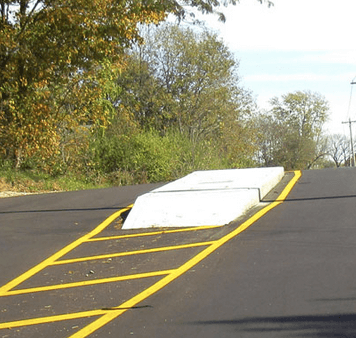
The Grave in the Middle of the Road
3. The Tree of the Dead
In Terre Haute, Indiana there stands the most massively disfigured cemetery tree I’ve ever encountered. Though its genus is no longer identifiable, it stretches at odd angles as if reaching out in despair.
It was a frigid January day when I encountered what I have since called “The Tree of the Dead.”
I’d been taking photos when my husband waved me over to see his find. Over the years I have seen hundreds of ominous cemetery trees, but none like this. This tree was surely waiting for the headless horseman to plunge through that opening with a rush of fetid air as he continued searching for his head.
Stepping closer, I attempted to take a photo, but the tree was having none of it. My camera shut down immediately. There are several explanations for this common cemetery occurrence; the batteries are too cold, connections are corroded, post seals are damaged, or spirits are sapping energy attempting to manifest. Yes, well … but after changing the batteries two more times, I had yet to get one picture.
My husband thrust his camera into my hands and I was able to get two photos before the batteries died. One shows the tree in all of its appalling façade with twisted limbs reaching akimbo to the sky. (Notice the limb with a dragon’s head at the end?)
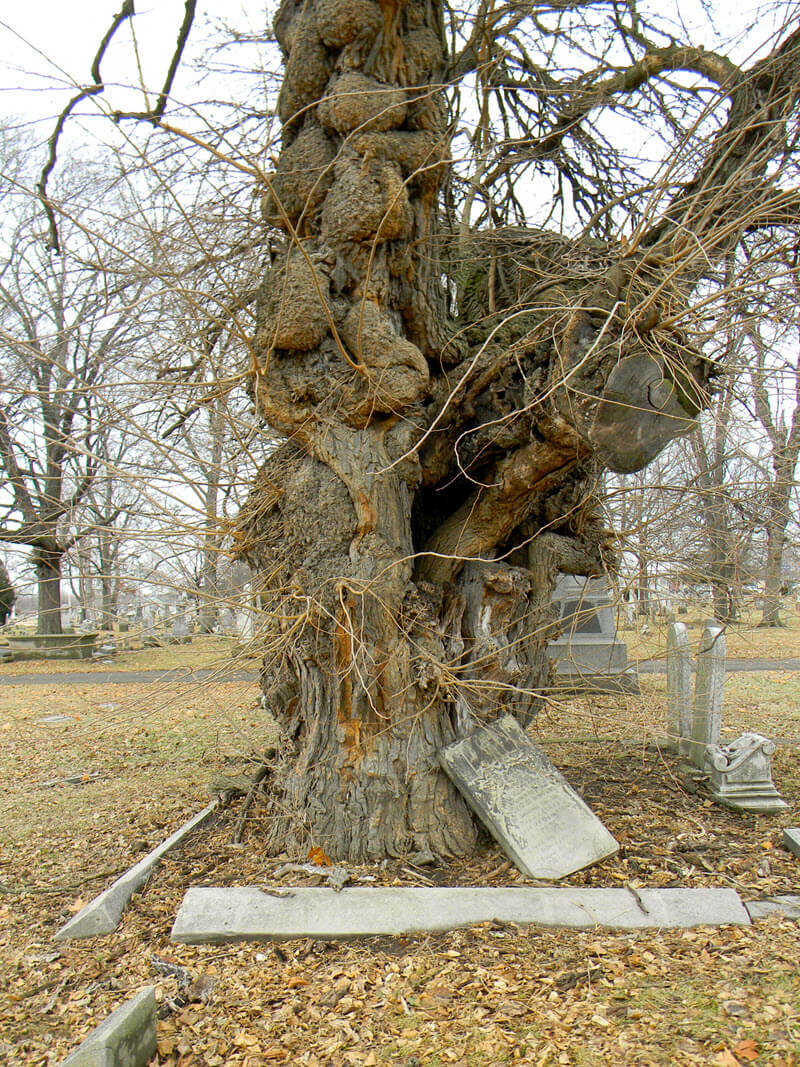 The second shot shows the opening in the middle of the tree: a bizarre heart shape. And the mishmash of tombstones scattered around the plot date to the late 1800s but names are indecipherable.
The second shot shows the opening in the middle of the tree: a bizarre heart shape. And the mishmash of tombstones scattered around the plot date to the late 1800s but names are indecipherable.
Who is buried here?
What happened to give the tree such an appearance?
Could it be caused by a decades-old drought?
Maybe arsenic used to embalm bodies back in the 19th century slowly leaching its way up into the tree?
Or could it be … something else?
A visual reminder of how perilously close fact and fiction are entwined in the graveyard.
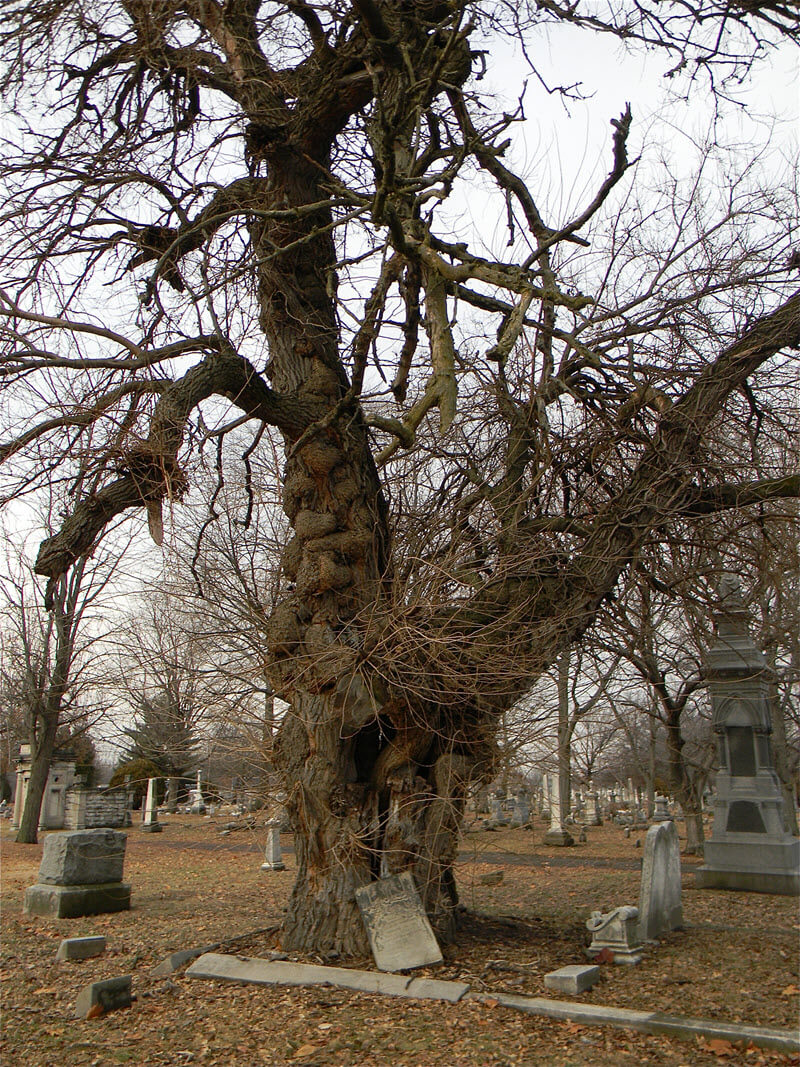
Cemetery Secrets
Cemeteries hold a vast amount of secrets, most of which we may never know. But the genealogist’s pursuit of answers means we’ll never stop exploring and asking the questions, and perhaps one day, those secrets taken to the grave may be revealed.
Cemeteries are crucial for any genealogist’s search, and The Family Tree Cemetery Field Guide by Joy Neighbors will show you how to search for and analyze your ancestors’ graves.
Discover tools for locating tombstones, tips for traipsing through cemeteries, an at-a-glance guide to frequently used gravestone icons, and practical strategies for on-the-ground research. And once you’ve returned home, learn how to incorporate gravestone information into your research, as well as how to upload grave locations to BillionGraves and record your findings in memorial pages on Find A Grave.
Click here to order your copy today!
Learn more about using Billion Graves:
(Click on player to unmute sound)
About the Author: Joy Neighbors is a national speaker, author, freelance writer, blogger, and avowed Tombstone Tourist. Her book, The Family Tree Cemetery Field Guide focuses on how to locate cemetery records, what to do when you get to the cemetery and how to understand the silent language of the stones. She also shares a few stunning family secrets along the way. Joy also writes the weekly cemetery culture blog, A Grave.

Disclosure: This article contains affiliate links and Genealogy Gems will be compensated if you make a purchase after clicking on these links (at no additional cost to you). Thank you for supporting Genealogy Gems!
How to Find German Villages for Family History
Show Notes & Video: Finding your German ancestor’s village is key to finding the genealogical records you need to go further back in your family tree. In this session you’ll learn:
- How and why it is important to know the “Heimat” because many records are kept on the local level.
- How to de garble a village name that is handed down to you (a common problem!)
- Records to search for village names.
- Resources for finding those records.
My guest presenter is James Beidler. He’s an expert on German genealogy and was gracious enough to share his expertise in the Genealogy Gems booth at Rootstech a few years ago. Visit James Beidler’s website. Get the book: The Family Tree Historical Atlas of Germany. (Thank you for using our affiliate link which supports this free content.)
Watch the Video
Show Notes
Downloadable ad-free Show Notes handout for Premium Members.
Researching your ancestors deep into Germany simply doesn’t happen unless you know the name of the village of origin. This presentation goes over the sources to tie your immigrant to a Heimat and then find the village and its records! HIghlighted in this article are the strategies and resources referred to in this video.
German Methodologies Review:
Your first job is to find every document of the immigrant ancestor or that mentions the immigrant ancestor:
- Prepare for surname variants
- “Redundancy” is a virtue (e.g., obit may well have something tombstone does not)
- Even items such as letters and diaries might give clues!
- Be prepared for village names to be corrupted
- Familiarize yourself with German maps / gazetteers
- Look for “patterns of association” with other individuals
- Process any piece of information that might distinguish the immigrant (e.g., occupation, names of other family members, etc.)
Utilize “whole family” genealogy
- If specific records don’t exist for your ancestor, try others in family
Look for published sources
- 1700s families: Burgert / Jones / Yoder / Hacker
- 1800s families: Burkett / Germans to America / Emigration indexes
Search International Genealogical Index
Search for:
- References to individual
- References to clusters of the surname if it is not common
- References to shipmates
- References to “associated persons”
Look for other sources of immigrant information:
- Heitmatstelle Pfalz immigrant card file
- Hamburg embarkation lists
- German phonebooks
- Google searches
Use the “concentric circles” strategy
- If a village is found for the above categories of people (surname, shipmates, associated persons) but your immigrant is not found …
- … work out from that village in “concentric circles” to other surrounding villages
“Things found on the way to something else”
- Machmer / Magemer / Mahomer example
- Never turn away luck!
Types of records that might yield a place of origin:
- Naturalizations
Declarations of intent (“first papers”) Naturalization petitions (“final papers”) - Baptisms of children
- Marriage Records
- Church burial records
- Tombstone
- Obituaries
- U.S. Census
- Family Bibles
- Family Registers
- Fraternal societies’ records
- Enlistment papers
- Discharge Papers
- Pension documents
- Letters from relatives
- Postmarks on letters
Internet Websites Resources for German Research
The resources listed below can help us answer some of the most common questions we ask as genealogists. Some examples of the questions and Websites that will help:
1. What was the village of origin for my German-speaking immigrant ancestor?
Brandenburg: Frankfurt an der Oder
Bremen Passenger Lists, 1920-39
Mecklenburg (Institute for Migration and Ancestral Research)
Northern Friesland (search Friesland)
2. How can I help untangle the garbled name of a village of origin?
Atlas des Deutschen Reichs by Ludwig Ravenstein 1883
GOV Genealogical Gazetteer (part of Genealogy.net supersite)
Comprehensive gazetteer of German places east of the Oder and Neisse rivers
3. How can I get in contact with possible relatives from my ancestor’s village of origin?
Das Telefonbuch (German telephone directory)
(Also – Google names of villages and find out which local tourist board the village is a part of – e-mail directly to them)
4. How can I find out about German archives?
FamilySearch wiki – for guides to Germany and its component states
Archivschule Marburg Portal D (list of archives)
Resources
Downloadable ad-free Show Notes handout for Premium Members.
Genealogy Gems Book Club: Q & A with Genealogist Nathan Dylan Goodwin, Author of The Sterling Affair
After a long day of genealogical research, what could be more satisfying than curling up with a good book about genealogical research?! Nathan Dylan Goodwin’s new book The Sterling Affair promises a satisfying return journey into the life of forensic genealogist Morton Farrier.
(This article includes affiliate links. If you decide to pick up a copy of this book, using our links for which we will be compensated by the book seller helps support our ability to bring author Q&A’s like this to your screen. Thank you!)
Click here to purchase your copy of The Sterling Affair
Goodwin sets the scene of his new book as follows:
“When an unannounced stranger comes calling at Morton Farrier’s front door, he finds himself faced with the most intriguing and confounding case of his career to-date as a forensic genealogist. He agrees to accept the contract to identify a man who had been secretly living under the name of his new client’s long-deceased brother.
Morton must use his range of resources and research skills to help him deconstruct this mysterious man’s life, ultimately leading him back into the murky world of 1950s international affairs of state.”
A Conversation with Author Nathan Dylan Goodwin
Don’t worry, we won’t be spoiling the exciting read you have ahead of you. Today I will be chatting with Nathan about his life as an author, his writing process, and how the main character, Morton Farrier, almost didn’t make it past the first book!
Lisa Louise Cooke: The Sterling Affair is your eighth novel in the Morton Farrier genealogical crime mystery series. When you first began writing the series did you imagine an eighth book? And today can you imagine even more?
Nathan: I literally had no concept that there would be so many books in the series! At first, it was written as a one-off, then I started to have ideas for two or three more.
I think when I wrote book three, The Orange Lilies, I knew that the series had plenty more scope, especially as DNA-testing was just beginning for genealogists, opening up a whole new world of potential storylines! As to the future of the series, I’m currently plotting books nine and ten. I don’t see an end to the series just yet!

Click the book image to order your copy.
Lisa Louise Cooke: I heard you speak at THE Genealogy Show conference in Birmingham England in 2019. In that presentation you told the audience that you almost killed off Morton at the end of the first book. I imagine you’re glad now that he survived. What exactly happened back then?
Nathan: Killing Morton would have been the most stupid thing I could have done!
I started writing Hiding the Past (the first book in the series) as part of my studies for a Master’s Degree in creative writing and I think I’d been reading a novel at the time, which went along the lines of ‘if you’re reading this then I’m dead’. I thought this angle might work for the first draft of my story but thankfully, as the book progressed, I was able to see several plotlines, which could continue into further stories.
I knew from the outset that I wanted the main character, Morton Farrier, to have been adopted and be totally unaware of his biological family, so there was plenty of scope there to continue that subplot in future books.
Lisa Louise Cooke: How has the advent of DNA testing changed the course of your writing?
Nathan: DNA-testing has completely changed the course of my writing—in a good way, I like to think! There are now so many more possibilities for Morton to solve his cases in different ways.
Morton took an Ancestry DNA test back in 2014 when it had not yet even become possible in the UK. He did what I had to do, which was to order one in the US and have a friend ship it over, then post it back to the US for testing and analysis!
From that point onwards, DNA has played an ever-increasing role in helping Morton to solve his cases. In the most recent book, The Sterling Affair, Morton uses a variety of real tools and websites which are familiar to genealogists.
Lisa Louise Cooke: When you start a book like The Sterling Affair, do you already have it well mapped out, or are there surprises even for you along the way as to the path it will take?
Nathan: I usually spend at least three months conducting research for the books. This involves reading, visiting record offices, libraries, churches, etc. Basically, anything which Morton does in the book, I do first.
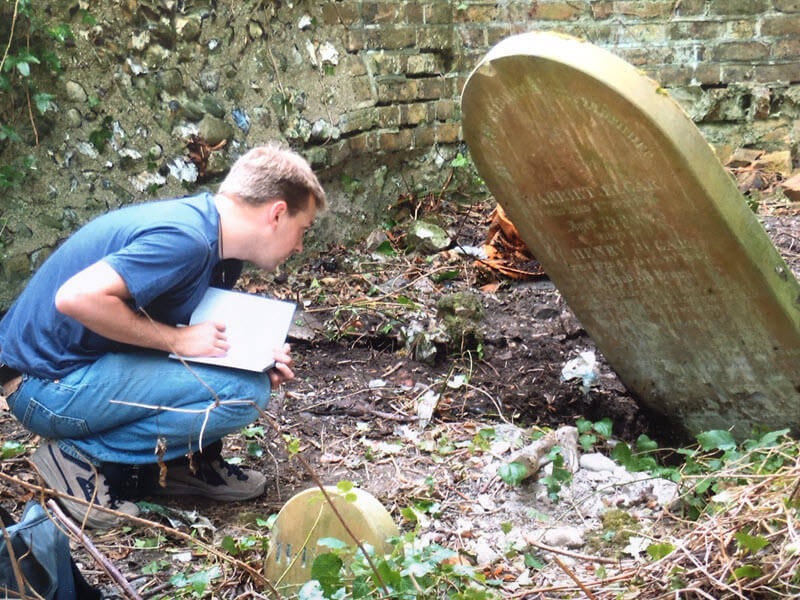
Photo courtesy of Nathan Dylan Goodwin
At the point when I actually start writing I probably have about 60% of the storyline mapped out. It’s a big cliché to say so, but for me the characters really do come to life and do things which I hadn’t anticipated. For the first few books I found it a little unnerving to be starting to write something that I didn’t know pretty well 100% what was going to happen, but now I trust myself and I know I’ll get to the end if I let the characters lead the way!
Lisa Louise Cooke: Where do you get your inspiration for the story lines in your books?
Nathan: My ideas come from a variety of sources, but never by actively searching for the next story; I just seem to stumble on a nugget of an idea, which I think could make for an interesting genealogical crime mystery and make a note of it! It can be a news story involving history or genealogy in some way, something I’ve picked up from a family history publication, or a Facebook group where people share their own genealogical mysteries.
Increasingly, the books have more real-life characters, plotlines and locations. For example, The Spyglass File, which is set on the frontline of Kent during the Battle of Britain, was loosely based on my grandmother’s story, whereby she gave birth to an illegitimate child in 1943, whom she put up for adoption whilst my grandfather was a POW in Thailand.

Nathan’s Grandmother – Photo courtesy of Nathan Dylan Goodwin.
The Sterling Affair is based on nefarious goings-on during the 1950s and involves real undercover MI6 operations and real spies. The idea for this story came from the National Archives newsletter, which mentioned the release of some previously closed MI6 records. This got me thinking about someone trying to conceal their real identity and Morton having to use his skills to work out who he might be!
Lisa Louise Cooke: For those new to your books, they will see that this is the eighth novel in the series and wonder if it’s too late to join in. Can the book be read and enjoyed as a stand-alone novel?
Nathan: I always say that the books can be read as a stand-alone, but you would be missing out on Morton’s backstory. However, with The Sterling Affair there is not too much given away about his own past, so, of all of the stories, this is the most readable out of sequence!
Lisa Louise Cooke: When you’re not writing about Morton Farrier, what is your favorite way to spend free time?
Nathan: I’m not sure what you mean by ‘free time’!? Obviously, I spend a lot of time on genealogy. I’ve been researching my own family for thirty years now and I feel very fortunate to be able to combine my two loves of writing and genealogy. Aside from that, I enjoy reading, running, skiing, theatre and spending time with my family, friends and dog.
Lisa Louise Cooke: You’re a man of many talents. Do you have other “wishlist” projects you yearn to do in addition to writing?
Nathan: I enjoy photography and would like to develop that at some point in the future and I really would like to take a watercolour painting class at some point. I just need some of that free time you mentioned!

A man of many talents – Photography by Nathan Dylan Goodwin
Lisa Louise Cooke: I’ll be at RootsTech again this year. Will we see you there?
Nathan: I shall have a booth at RootsTech SLC this year signing books and also at THE Genealogy Show in Birmingham once again. So people can come and say hello and let me know what they think of my stories. I love chatting with my readers!
Hear More from Nathan Dylan Goodwin
Read and hear more from genealogical author Nathan Dylan Goodwin in the following exclusive Genealogy Gems content:
- Genealogy Gems Podcast episode 180 features an Interview with Nathan Dylan Goodwin author of The Lost Ancestor.
- Genealogy Gems Podcast episode 179 features a discussion of The Lost Ancestor by Nathan Dylan Goodwin.
- Interview with Nathan Dylan Goodwin: Genealogy Gems Book Club – In this article from 2015 Nathan discusses the second book in the Morton Farrier series, The Lost Ancestor.
- Listen to the full-length Genealogy Gems Book Club interview with Nathan Dylan Goodwin, as he discusses The Lost Ancestor (The Forensic Genealogist) in Genealogy Gems Premium Podcast episode 125 (exclusive for Genealogy Gems Premium Members.)
- Listen to our interview with Nathan Dylan Goodwin about his The Wicked Trade and The Suffragette’s Secret in Genealogy Gems Premium Podcast episode 159 (exclusive for Genealogy Gems Premium Members.
Catch up on the Morton Farrier
Learn more about the entire book series featuring Morton Farrier here in this Genealogy Gems Book Club article.
New Genealogy Records Available Online April 15 – May 15, 2020
With so many new records coming online, I’m going to focus today on collections that are new, or have had a substantial update. These records are from around the world, and offer excellent opportunities to expand your genealogical research.
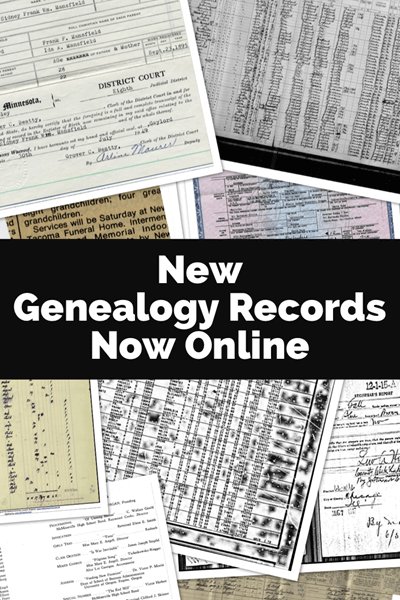
Keep reading here at Genealogy Gems for all the latest new records.
New Record Collections at FamilySearch
New indexed record collections offer new hope for genealogists yearning to bust a brick wall in their family tree. FamilySearch has recently launched several noteworthy new genealogical record collections. Some have substantial amounts of new records and some are just getting started. As always, they are free to access with an account. Here’s the latest:
England
England, Devon, Plymouth Prison Records, 1821-1919
Indexed Records: 13,495
Germany
Germany, Saxony, Church Book Indexes, 1500-1900
Indexed Records: 32,709
Ireland
Ireland, John Watson Stewart, The Gentlemen’s and Citizen’s Almanac, 1814
Indexed Records: 17,266
Norway
Norway, Oslo, Akershus Prison Records, 1844-1885
Indexed Records: 808
Peru
Peru, Piura, Civil Registration, 1874-1996
Indexed Records: 878
United States
California
California, Geographical and Name Index of Californians who served in WWI, 1914-1918
Indexed Records: 27,306
Hawaii
Hawaii, Hawaiian Islands Newspaper Obituaries, 1900-ca.2010
Indexed Records: 243
Maine
Maine, Alien Arrivals, 1906-1953
Indexed Records: 199,010
New Mexico
New Mexico Alien Arrivals, 1917-1954
Indexed Records: 17,240
Oregon
Oregon Death Index, 1971-2008
Indexed Records: 1,063,054
Oregon Divorce Index, 1991-2008
Indexed Records: 340,289
U.S. Newspapers
United States, GenealogyBank Historical Newspaper Obituaries, 1815-2011
Indexed Records: 1,827,447
Updated Records at FamilySearch
FamilySearch has also added indexed records to several interesting existing collections:
United States
United States, New York Land Records, 1630-1975
Indexed Records: 3,868,777
New York, Southern District, U.S District Court Naturalization Records, 1824-1946
Indexed Records: 103,000
Michigan, Detroit Manifests of Arrivals at the Port of Detroit, 1906-1954
Indexed Records: 323,121
Austria
Austria, Vienna, Jewish Registers of Births, Marriages, and Deaths, 1784-1911
Indexed Records: 27,317
Added indexed records to an existing collection comprising 1.8 million historical records.
Chile
Chile, Catholic Church Records, 1710-1928
Indexed Records: 8,575
Chile, Cemetery Records, 1821-2015
Indexed Records: 87,220
Italy
Italy, Benevento, Civil Registration (State Archive), 1810-1942
Indexed Records: 155,594
Italy, Brescia, Civil Registration (State Archive), 1797-1943
Indexed Records: 78,275
Italy, Salerno, Civil Registration (State Archive), 1806-1949
Indexed Records: 32,447
Images: 31,969
Peru
Peru, Diocese of Huacho, Catholic Church Records, 1560-1952
Indexed Records: 260,438
Venezuela
Venezuela, Archdiocese of Valencia, Catholic Church Records, 1760, 1905-2013
Indexed Records: 306,392
MyHeritage
MyHeritage, the leading global service for discovering your past and empowering your future, announced today the publication of three important Greek record collections:
- Greece, Electoral Rolls (1863–1924),
- Corfu Vital Records (1841–1932),
- and Sparta Marriages (1835–1935),
comprising 1.8 million historical records. Click here to start a 14-day free trial at MyHeritage.
This release constitutes the first substantial set of Greek record collections available on MyHeritage. All three collections have been indexed by MyHeritage and for the first time are now searchable in English, as well as in Greek. The total size of MyHeritage’s historical record database is now 12.2 billion records. This release positions MyHeritage as an invaluable genealogy resource for family history enthusiasts who have Greek roots.
“As the cradle of western civilization and a crossroads of continents and cultures, Greece is becoming a gem among MyHeritage’s historical record collections. The records in these collections are rich in detail and have pan-European, Balkan, and Mediterranean significance. The communities documented were shaped by Greek, Italian, French, and Russian influences, have been home to significant Catholic and Jewish communities, and represent some of the world’s most progressive systems of governance. These collections will prove valuable both to novice researchers and experienced genealogists,” said Russ Wilding, Chief Content Officer of MyHeritage.
The publication of these collections furthers MyHeritage’s commitment to providing new avenues for Greek family history research. In one of the company’s pro bono initiatives, MyHeritage Founder and CEO Gilad Japhet personally traced the descendants of a Jewish family that was hidden during World War II on the small island of Erikoussa, north of Corfu. The entire population of the island collectively gave refuge to the family, and saved it from death. His genealogical detective work, combined with MyHeritage’s extensive global database of historical records, culminated in recognition for the courageous people of Erikoussa, who were presented with the House of Life award by the Raoul Wallenberg Foundation. This was depicted in the books ‘When the Cypress Whispers’ and ‘Something Beautiful Happened’ by Yvette Manessis Corporon, whose grandmother was among those who saved the Jewish family on Erikoussa.
Japhet utilized his hands-on experience in Greek research to develop the enhanced method by which MyHeritage now handles Greek surnames in the new collections. In Greece, a woman’s last name is the genitive form of her father’s surname, or when she marries, of her husband’s surname. The new Greek collections on MyHeritage have been made gender-agnostic so that searches and matches will work to the fullest extent. For example, a search for the Jewish surname “Velleli” in the new collections on MyHeritage will also locate people named “Vellelis”. It is also possible to find these surnames by searching for “Belleli”, because the Greek letter beta is pronounced like the English letter V, but in some countries this distinction has been lost and Greek surnames are sometimes pronounced with the letter B, the way they are written in modern English. MyHeritage’s Global Name Translation Technology further ensures that when searching on MyHeritage in other languages, such as Hebrew and Russian, the results will also include names in the new Greek collections. No other major genealogy company has these Greek record collections, nor such sophisticated algorithms customized for Greek genealogy research.
The Greece Electoral Rolls (1863–1924) consist of 1,006,594 records and provide nationwide coverage of males ages 21 and up who were eligible to vote. They list the voter’s given name, surname, father’s name, age, and occupation. Each record includes the individual’s name in Greek, and a Latinized transliteration of the name that follows the standard adopted by the Greek government. MyHeritage translated many of the occupations from Greek to English and expanded many given names, which are often abbreviated in the original records. This new collection includes scans of the original documents and is the most extensive index of Greek electoral rolls currently available anywhere.
The Corfu Vital Records (1841–1932) consist of 646,807 birth, marriage, and death records. The records were collected by the civil authorities in Corfu and document the life events of all residents of the island regardless of their ethnicity or religion. Birth records from this collection may contain the child’s given name and surname, birthdate and place of birth, name and age of both parents, and the given names of the child’s grandfathers. A marriage record from this collection may include the date of marriage, groom’s given name and surname, age, place of birth, residence, and his father’s name. Similar information is recorded about the bride and her father. Death records in this collection may include the name of the deceased, date of death, age at death, place of birth, residence, and parents’ names. The indexed collection of Corfu Vital Records includes scans of the original documents and is available exclusively on MyHeritage.
The Sparta Marriages collection (1835–1935) consists of 179,411 records which include images of the couple’s marriage license and their listing in the marriage register. The records in this collection list the full names of the bride and groom, the date of marriage, their fathers’ names, the birthplace of the bride and groom, and occasionally the names of witnesses to the marriage. The images in this collection were photographed, digitized, and indexed by MyHeritage from the original paper documents, in cooperation with the Metropolis of Monemvasia and Sparta.
The new collections are available on SuperSearch™, MyHeritage’s search engine. Searching the Greek record collections is free. A subscription is required to view the full records and to access Record Matches. Click here to start a 14-day free trial at MyHeritage.
Ancestry
Alabama
Alabama, Episcopal Diocese of Alabama, Church Records, 1837-1970
From Ancestry: “This collection includes baptism, marriage, and burial records from the Episcopal Diocese of Alabama between the years of 1837 and 1970. Established in 1830, the Episcopal Diocese of Alabama is comprised of 92 congregations and covers all of Alabama, with the exception of the very southern portion of the state.”
Click here to search this collection.
Oregon
Oregon, State Marriages, 1906-1966
The original data comes from the Oregon State Archives. Oregon, Marriage Records, 1906-1910, 1946-1966. Salem, Oregon.
Click here to search this collection
Oregon, State Births, 1842-1917
These birth certificates will typically include the following information:
- Name of child
- Gender and race of child
- Date and place of birth
- Father’s name
- Father’s birth place and age
- Mother’s name
- Mother’s birth place and age
Click here to search this collection
Pennsylvania
U.S., Pennsylvania, Grand Army of the Republic Membership Records, 1865-1936
These records are made available through a partnership with FamilySearch. The describe the collection as follows: “Index and images of membership records of the Pennsylvania Department Grand Army of the Republic that cover from the years 1865-1936. An organization of Union army and navy veterans of the Civil War. The collection consists of registers, lists, minute, account and descriptive books of local post (chapters) The descriptive books include town of residence, military unit, date of enlistment,date of discharge, age and birthplace. The collection was acquired from the Pennsylvania State Archives.”
Click here to search the collection.
Washington
WEB: Washington, Various County Census Records, 1850-1914
The original data for this collection comes from the Washington State Archives – Digital Archives. Census Records. Cheney, Washington, United States: Washington State Archives – Digital Archives.
Click here to search the collection.
Finland
Finland, WWII Military Casualties, 1939-1945
In this collection you will find details on Finnish soldiers killed during World War II. From Ancestry: “From the start of the war until 1944, Finland was involved in battles with the Soviet Union and from 1944-1945, Nazi Germany. Altogether, nearly 95,000 Finnish soldiers were killed or declared missing in action.” The National Archives of Finland created these indexes. They are in Finnish, reflecting the original source material.
Click here to search this collection
Germany
Germany, Military Killed in Action, 1939-1948
Notes about this collection from Ancestry: “This collection is searchable using the search form, which among other things allows you to search by Last Name, First Name, Birth Date, Birthplace, Date of Death and Place of Death. Under “Browse this collection,” you can select the Box Number Range and Box Number of the cards desired.”
Click here to search the collection.
German Concentration Camp Records, 1946-1958
These records include copies of German records including camp records, transport lists, and medical data cards. The camp records include inmate cards, death lists, and strength reports.
Click here to search this collection
Updated Records at Ancestry:
New York
New York, Passenger and Crew Lists (including Castle Garden and Ellis Island), 1820-1957
Click here to search this collection
New York, Executive Orders for Commutations, Pardons, Restorations, Clemency and Respites, 1845-1931
39,246 new records have been added to this collection of executive clemency application ledgers and correspondence.
According to Ancestry: “Each record includes the felon’s name, crime, date and county of conviction, sentence, and prison. Signatures on the records can include the governor, secretary of state, and/or deputy secretary of state.”
Click here to search the collection.
North Dakota
North Dakota, Select County Marriage Records, 1872-2017
30,266 new records were added for the following counties in Washington State: Adams, Cavalier, Hettinger, McIntosh, Nelson, and Pierce.
Search Tips from Ancestry:
- This collection includes images of indexes as well as the actual marriage records. If you’re having trouble finding your ancestor through the search, try browsing the index for the county in which they lived and use that information to locate them in the actual records.
- Don’t overlook the possibility that your ancestor may have been married in a nearby county that was more convenient to them, or where other family members lived.
Click here to search this collection
Tennessee
Tennessee, Death Records, 1908-1965
This is a significant update with 1,019,533 new records added covering 1959-1965. Be aware that, according to Ancestry, the forms used for reporting deaths 1908-1912 contain far less information than those used from 1914 forward. “No death records were recorded by the State of Tennessee in 1913 due to a change in the state law requiring vital records registration.”
Click here to search this updated collection.
More Genealogy for You
Join me for Elevenses with Lisa, the online video series where we take a break, visit and learn. In the episode below I share viewers’ family history displays, answer your questions about my genealogy organization method, and show you how I file my genealogy digital files. Click here for the episode show notes.

